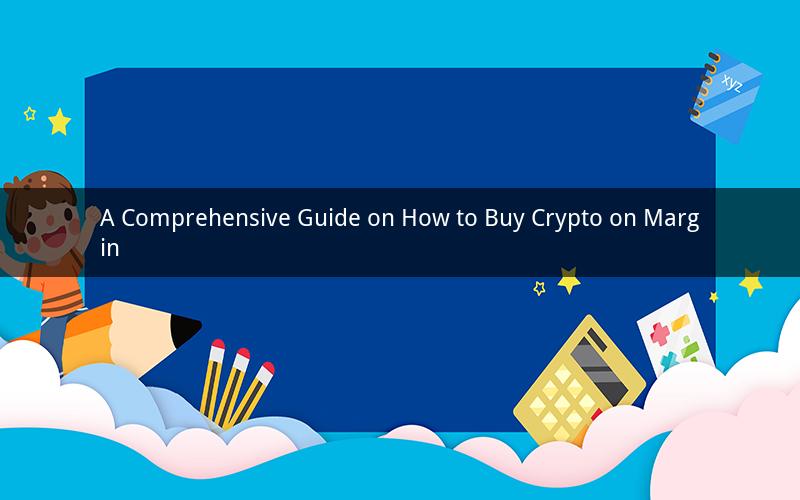
Introduction:
Investing in cryptocurrencies has become increasingly popular, and margin trading offers an exciting opportunity for investors to amplify their gains. However, margin trading also involves higher risks. In this article, we will delve into the process of buying crypto on margin, covering the basics, potential benefits, risks, and practical steps to help you navigate this exciting market.
Section 1: Understanding Margin Trading
1.1 What is Margin Trading?
Margin trading is a method of trading that allows investors to borrow funds from a broker to increase their position size. This means that you can buy more crypto than you have in your own wallet, using borrowed capital. Margin trading is often referred to as "leveraged trading" due to the use of leverage.
1.2 How Does Margin Trading Work?
When you engage in margin trading, you are essentially using borrowed capital to purchase crypto. The borrowed funds are secured by your assets, which act as collateral. If the value of your assets decreases, you may face a margin call, requiring you to deposit additional funds to cover the shortfall.
Section 2: Benefits of Margin Trading
2.1 Amplified Gains
One of the primary benefits of margin trading is the potential for amplified gains. By using leverage, you can increase your position size, which means you have the opportunity to earn more if the market moves in your favor.
2.2 Increased Market Access
Margin trading allows you to participate in the crypto market even if you don't have enough capital to buy the desired amount of crypto. This can be particularly beneficial for new investors or those with limited funds.
2.3 Short Selling
Margin trading also enables short selling, which is the practice of selling borrowed assets with the expectation that their value will decrease. This can be a powerful tool for hedging or profiting from market downturns.
Section 3: Risks of Margin Trading
3.1 Leverage Risk
The use of leverage can amplify both gains and losses. If the market moves against you, you may face significant losses, potentially even exceeding your initial investment.
3.2 Margin Calls
A margin call occurs when the value of your assets falls below a certain threshold, requiring you to deposit additional funds to cover the shortfall. Failing to meet a margin call can result in your assets being liquidated to cover the borrowed funds.
3.3 Market Volatility
Cryptocurrencies are known for their high volatility. This can lead to rapid price swings, which can result in significant gains or losses in a short period of time.
Section 4: Steps to Buy Crypto on Margin
4.1 Choose a Margin Trading Platform
To begin margin trading, you need to choose a reputable platform that offers margin trading. Research and compare different platforms based on fees, available assets, and user reviews.
4.2 Open a Margin Trading Account
Once you have chosen a platform, you will need to open a margin trading account. This typically involves verifying your identity and completing the necessary documentation.
4.3 Deposit Collateral
Before you can start trading, you need to deposit collateral in your margin trading account. This can be in the form of fiat currency or crypto assets.
4.4 Borrow Funds
Once you have deposited collateral, you can borrow funds from your broker to increase your position size. The amount you can borrow depends on the leverage ratio and the value of your collateral.
4.5 Place a Trade
With the borrowed funds, you can place a trade in the crypto market. Decide on your entry and exit points, and monitor your position closely to manage risks.
Section 5: Best Practices for Margin Trading
5.1 Risk Management
Implement a robust risk management strategy to protect your investments. Set stop-loss orders to limit potential losses and avoid over-leveraging.
5.2 Continuous Learning
Stay informed about market trends, news, and developments in the crypto space. Continuous learning can help you make informed decisions and adapt to changing market conditions.
5.3 Patience and discipline
Maintain patience and discipline in your trading strategy. Avoid chasing losses or becoming greedy, as these emotions can lead to poor decision-making.
5.4 Diversify Your Portfolio
Diversify your portfolio to spread out risk. Investing in a variety of crypto assets can help mitigate the impact of market volatility.
Conclusion:
Buying crypto on margin can be a powerful tool for investors looking to amplify their gains. However, it is crucial to understand the risks and follow best practices to navigate this exciting market successfully. By choosing a reputable platform, depositing collateral, and implementing a disciplined trading strategy, you can take advantage of margin trading to potentially boost your crypto investments.
Questions and Answers:
1. Q: What is the maximum leverage ratio available for margin trading?
A: The maximum leverage ratio varies by platform and asset. Some platforms offer leverage ratios as high as 100:1.
2. Q: Can I lose more than my initial investment in margin trading?
A: Yes, margin trading involves leverage, which can amplify both gains and losses. It is possible to lose more than your initial investment.
3. Q: How can I avoid margin calls in margin trading?
A: To avoid margin calls, closely monitor your position's value and ensure you have enough collateral in your account. Set stop-loss orders to minimize potential losses.
4. Q: Are there any fees associated with margin trading?
A: Yes, margin trading platforms typically charge fees for borrowing funds, interest rates, and transaction fees. Be sure to review the fee structure before engaging in margin trading.
5. Q: Is margin trading suitable for beginners?
A: Margin trading is not recommended for beginners due to its higher risks and complexity. It is advisable to gain experience in the crypto market before venturing into margin trading.